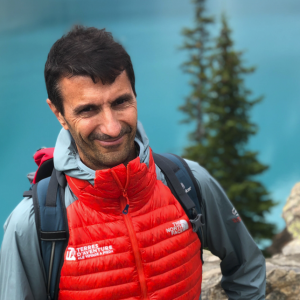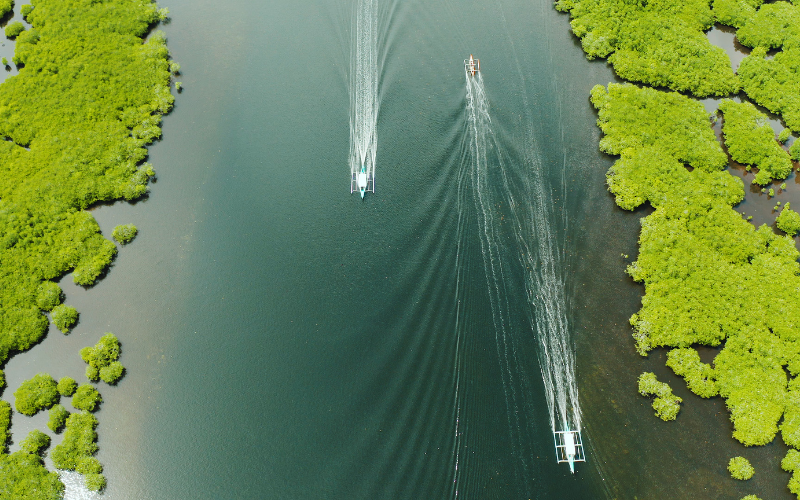One of the most common questions I receive when chatting with travel company leaders is, “what can you tell me about how other companies are tackling their climate strategies?” One of the reasons more of these stories aren’t widely circulated is that they’re emerging from within businesses whose teams don’t always have the capacity to create and market case studies of themselves.
In the coming months, I will conduct interviews with a few companies willing to share their stories in the hopes that their lessons learned can help inspire and inform. I also encourage those who are interested to join the member community at Tourism Declares where it is very easy to meet people tackling the same issues. Have a question you want me to ask in my conversations? Comment below or email me directly [email protected].
Eric Balian, Terres d'Adventure

I’m kicking off with a conversation with Eric Balian of Terres d’Aventure, a company based in France that has been evolving its climate strategy for more than twenty years. Terres d’Aventure was the first company to measure, reduce and absorb the greenhouse gas emissions of its staff as well as those of customers.
Learn from their journey in this two-part series beginning today.
When did the climate action journey for Terres d’Aventure begin?
At Terres d'Aventure, absorbing the carbon we emit during our travels has been a long-standing concern. We began working on this subject in the early 2000s, following the signing of the Kyoto Protocol by the United Nations, the first international agreement on global warming.
As early as 2005, we implemented forest ecosystem restoration programs that allowed us, at the time, to absorb 10 percent of our customers' GHG emissions and 100 percent of the company and employee carbon emissions.
Today we absorb 100 percent of the GHG emissions of all our trips, whether they are related to air transport, land activities, our customers' trips or the activity of the company and our employees.
How would you summarize your climate strategy today?
Our strategy can be summarized in 3 points:
- Measure
- Reduce
- Absorb
Measure
Before any action, we believe it is absolutely necessary to measure all our greenhouse gas emissions in order to know if our actions have any effect on our emissions. We spent a lot of time in finding the right way to do so.
Like anybody, when we started this process, getting the right data to have a precise calculation of our emissions was quite a challenge. Our approach was not to be "more Catholic than the Pope.” When you start such a process, it is a classic error to try and be very precise on all details and realize that you will spend months retrieving all the data to make a correct calculation on your emissions: all employee's routes and transportation means to come to the office, all customers flight schedule, details of electricity bills, etc.
Like anybody, when we started this process, getting the right data to have a precise calculation of our emissions was quite a challenge. Our approach was not to be "more Catholic than the Pope.”
So we first decided to make some rough calculations. For instance, at the beginning, we were not precisely calculating emissions on land operations as they are representing only an average of ten percent of greenhouse gas emissions on a trip including a flight.
Since then, we have made a lot of progress in this aspect. We have much more precise calculations for any trip, and any customers. But this has been the result of an ongoing process.
Reduce emissions as much as possible. Once you know the emissions produced by each trip, you can start working on reduction.
It is always interesting to make it part of your trip creation process. Can we access the destination by train instead of plane? Can I replace destination internal flights by train, or land transport? Can I design the trip in the destination in such a way that I reduce transfers? Can I make daily transfers by bike instead of car? Can I make sure that local food is always available every day? How can I reduce plastic usage in daily operations? For us, it is important to think "CO2 reduction by design".
It is the same for all greenhouse gas emissions produced by the company and its employees. Changing our standard electricity provider to one that offers renewable electricity, installing centralized electricity switches to ensure that all lights are closed every night, challenging employees to switch off their computer and their screen when they leave the office, forbidding any internal plane trip if an alternative train solution exists with a less than 4 hours duration, we established policies for all these types of things.
Absorb–contribute to carbon neutrality by investing in projects to restore forest ecosystems, mainly mangroves.
Despite all reduction efforts we can do, we will still emit greenhouse gases in our activity. This is why we have decided to absorb what remains.
To absorb our carbon dioxide emissions, we have chosen to give priority to ecosystem restoration and agroforestry projects. Why this choice? By contributing to the replanting of thousands of hectares of mangroves and forest, these projects make it possible to capture hundreds of thousands of tons of greenhouse gas emissions, the equivalent of all the emissions linked to our travels. Our projects are also chosen for their high societal value, with an emphasis on educating local populations, in order to make them aware of the importance of their ecosystem and its preservation
All of the projects we carry out are VERRA (vera.org ) or Gold Standard (www.goldstandard.org ) certified projects. These are international certifications that impose very strict rules for carbon reduction projects. One of the important criteria of these standards is that of additionality: a project can only be certified if it can provide proof that without the investment made in this project, the associated emissions absorption would never have existed. It must therefore be additional and therefore provide a guarantee of additional carbon capture. These organizations also impose regular and independent on-site audits for each project in order to observe and verify their effectiveness in terms of carbon absorption.
An important subject for us was also to decide what to do with carbon certificates. For each certified project we invest in, we obtain carbon credits. We never resell these carbon credits and to cancel them from our accounts.
Given the long time Terres d’ Aventure has been incorporating climate actions into your company practices, what would you say have been the greatest surprises/learnings along the way?
The greatest surprises or learnings we experienced along the way are quite a few!
- The first learning is to have a progressive approach. Don't try to be fanatic about having the right figures for everything. This will come with time. It is always better to start with something instead of doing nothing before you get all the information. You will never get it and for such a subject it will never be perfect.
- Another surprise was to discover that certain carbon dioxide absorption projects can be against your interest. We were about to start a project in Amazonia which objective was to plan nut trees. This was very interesting at the beginning. But when we visited the project there, we realized that the nuts were destinated to make oil for gasoline. How could we invest on a project that would have eventually produced gasoline? This was a key learning for us: go and visit the project you invest on.
How do you see your approach evolving in the coming decade?

Climate consciousness has really grown up in the last five years. This has led to a growing demand for reforestation projects. The cost of these projects is increasing sharply. Reforestation will still remain one of the main type of carbon dioxide absorption project for us but there will be a need to orientate investment towards other projects like carbon removal projects. These are still far too expensive to be used as our total carbon absorption strategy, but as investments grow up, their cost will be progressively reduced.
I also believe we need to do more than absorb 100 percent of our emissions. Companies like ours not only need to be carbon neutral. We have to be carbon positive. We then need to motivate all the travel ecosystem (providers, employees, and customers) in order to absorb more than we emit. We are on the way.
We will also integrate even more "carbon dioxide reduction by design" in our trip development and in our tour mix. More train accessible trips in Europe, longer duration for long-distance trips, etc.
What advice do you have for other businesses developing their climate strategies?
My main advice would be to have a step by step approach, with a limited objective for each step and objectives compatible with what your company can afford:
- First, choose a credible method to calculate your carbon dioxide emissions
- Then use this method to understand what data you will need, set up your data collection plan, and make your first estimation. This step will progress with time and experience
- Decide what spending you can start with for your climate strategy. Don't be ashamed if it only represents ten percent of what you would need to absorb all your emissions. It will always be better to do ten percent than nothing
- Be very transparent about what you do, how you do it, and what is the limit of your action
- Improve every year until you reach…. 100 percent
- A real learning was also to do things because you really are convinced you have to do it, not because "being green" is a trendy marketing thing. The process is long, can be time-consuming, and costs money. So if you're not deadly convinced, you will miss something, your message will not be good and your customers will understand and realize that. You also need to be transparent, to detail what you do, how you do it, and what is the limit of your action.
Stay tuned for my follow-up with Eric, in which I ask him specifically about the internal tools used at Terres d’Aventure to track emissions and the adaptations in company processes to incorporate emissions measurement, what the company’s commitment to climate has meant for customers in terms of price increases and what the reaction has been, and more about his specific thoughts on carbon removal innovations in this area.
